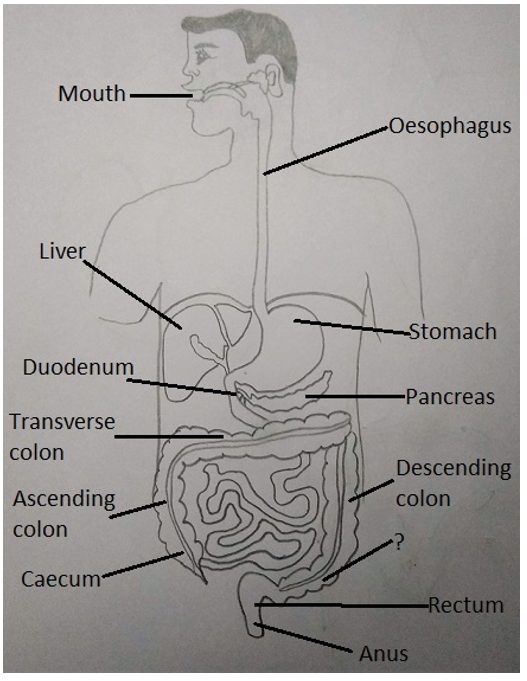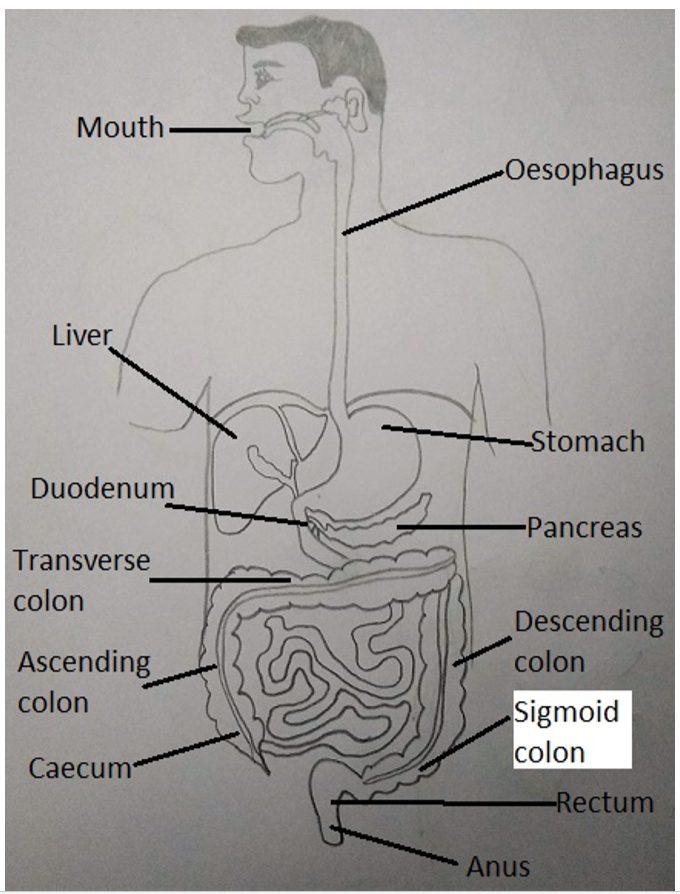This set of Class 11 Biology Chapter 16 Multiple Choice Questions & Answers (MCQs) focuses on “Digestion and Absorption”. These MCQs are created based on the latest CBSE syllabus and the NCERT curriculum, offering valuable assistance for exam preparation.
1. Which of the following is not a major component of the food?
a) Carbohydrates
b) Proteins
c) Vitamins
d) Fats
View Answer
Explanation: The major components of our food are carbohydrates, proteins and fats. Vitamins and minerals are also required in small quantities in our diet.
2. What does food provide for us?
a) Energy and water
b) Energy and organic material
c) Energy and nitrogen
d) Only energy
View Answer
Explanation: Food is one of the basic requirements of all living organisms. Food provides energy and organic materials for growth and repair of tissues. The water we take in plays an important role in metabolic processes.
3. What is digestion?
a) Conversion of complex bio-macromolecules to simple absorbable forms
b) Conversion of complex biomolecules to a simple form
c) Conversion of complex bio-micromolecules to a simple form
d) Conversion of simple biomolecules to complex form
View Answer
Explanation: This process of conversion of complex food substances to simple absorbable forms is called digestion and is carried is out by our digestive system by mechanical and biochemical methods.
4. Bio-micromolecules in food cannot be utilised by our body in their original formal.
a) True
b) False
View Answer
Explanation: Bio-macromolecules in food cannot be utilised by our body in their original form as they are too big to be absorbed by our blood capillaries or the lacteals, therefore they have to be broken down into very small substances so that they can get easily absorbed.
5. What does our digestive system consists of?
a) Alimentary canal and associated glands
b) Alimentary canal only
c) Digestive glands only
d) Mucous glands
View Answer
Explanation: The human digestive system consists of the alimentary canal and the associated glands. The alimentary canal begins with an anterior opening-the mouth, and it opens out posteriorly through the anus.
6. Where does the mouth lead into the alimentary canal?
a) Pharynx
b) Larynx
c) Oral cavity
d) Tongue
View Answer
Explanation: The mouth leads to the buccal cavity of the alimentary canal. The buccal cavity is also known as the oral cavity. The oral cavity has a number of teeth and a muscular tongue.
7. According to food habit, what kind of teeth are present in human beings?
a) Bunodont
b) Secodont
c) Selenodont
d) Lophodont
View Answer
Explanation: In human beings, cusps of teeth are small and blunt. These kid of teeth are called as bunodont teeth. Secodont, selenodont and lophodont teeth are present in carnivores, cattle and elephant respectively.
8. What is a diphyodont type of dentition?
a) Two types of teeth only
b) Two phases of gums and teeth
c) Three types of teeth
d) Two sets of teeth during life
View Answer
Explanation: Diphyodont is a type of dentition which consists of two sets of teeth during the entire life cycle of the organism. Majority of mammals including human beings form two sets of teeth during their life. One set which is the milky teeth get replaced by the new set of teeth by the age of 12-13 years.
9. How many different types of teeth are present in humans?
a) Two
b) Three
c) Four
d) Five
View Answer
Explanation: There are 4 different types of teeth present in a human being which include- incisors, canines, pre-molars and molars. The last set of molars or the wisdom teeth are vestigial in human beings.
10. Which of the following makes the hard chewing surface of the teeth?
a) Enamel
b) Dentine
c) Root canal
d) Pulp cavity
View Answer
Explanation: The hard chewing surface of the teeth is made up of enamel that helps in the mastication of food. Heterodont type of dentition is present in human beings.
11. By which of the following structures tongue is attached to the oral cavity?
a) Fingulum
b) Lingulum
c) Frenulum
d) Papillae
View Answer
Explanation: The tongue is a freely movable muscular organ attached to the floor of the oral cavity by the frenulum. The upper surface of the tongue has small projections called papillae, some of which bear taste buds.
12. What does the question mark represent in the following figure?

a) Transverse colon
b) Ascending colon
c) Descending colon
d) Sigmoid colon
View Answer
Explanation: The given figure represents the human digestive system. General organisation of the human digestive system is as follows:

13. The oral cavity leads into the trachea.
a) True
b) False
View Answer
Explanation: The oral cavity leads into a short pharynx which serves as a common passage for food and air. Arrangement of tonsils in a ring-like manner in the pharynx is called as Waldeyer’s ring.
14. Epiglottis is made up of which of the following tissues?
a) Ligament
b) Tendon
c) Cartilage
d) Bone
View Answer
Explanation: A cartilaginous flap called epiglottis prevents the entry of food into the glottis- the opening of the windpipe-during swallowing. The oesophagus and the trachea open into the pharynx.
15. Which of the following is not correct regarding oesophagus?
a) Thick
b) Long tube
c) Passes through neck
d) Extends posteriorly
View Answer
Explanation: The oesophagus is a thin, long tube which extends posteriorly passing through the neck, thorax and diaphragm and leads to a ‘J’ shaped bag-like structure called a stomach.
More MCQs on Class 11 Biology Chapter 16:
- Chapter 16 – Digestion and Absorption MCQ (Set 2)
- Chapter 16 – Digestion and Absorption MCQ (Set 3)
- Chapter 16 – Digestion and Absorption MCQ (Set 4)
To practice all chapters and topics of class 11 Biology, here is complete set of 1000+ Multiple Choice Questions and Answers.
If you find a mistake in question / option / answer, kindly take a screenshot and email to [email protected]
- Practice Class 11 - Mathematics MCQs
- Check Class 11 - Books
- Practice Class 11 - Chemistry MCQs
- Practice Class 11 - Physics MCQs
- Practice Class 12 - Biology MCQs
